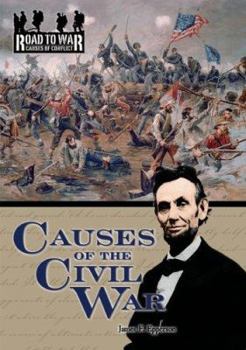Causes of the Civil War
Select Format
Select Condition 
Book Overview
The American Civil War was the bloodiest conflict in American history. Some 620,000 Americans lost their lives during the four-year struggle that began at Fort Sumter on April 12, 1861. This book... This description may be from another edition of this product.
Format:Paperback
Language:English
ISBN:1595560068
ISBN13:9781595560063
Release Date:August 2005
Publisher:Ottn Publishing
Length:64 Pages
Weight:0.35 lbs.
Age Range:8 to 12 years
Grade Range:Grades 3 to 7
Customer Reviews
2 ratings
Outstanding titles
Published by Thriftbooks.com User , 17 years ago
The "Road to War: Causes of Conflict" series from OTTN Publishing features outstanding titles that introduce young readers in grades 4 through 6 to the causes of five American wars over the last two hundred years that saw significant American involvement. This series includes: Causes Of The American Revolution, Causes Of The Civil War, Causes Of World War I, Causes Of World War II, and Causes Of The Iraq War. Each title presents a truly in-depth survey of the reasons for America's involvement in these conflicts along with an articulate explanation of events and concepts. The fourth grade reading level texts are enhanced with more than 25 color photographs, illustrations, and maps. Although Causes of the American Revolution and Causes of the Civil War are available in paperback, the sturdy library binding of the hard cover edition is recommended for school and library collections.
An excellent distilling of the causes of the American Civil War for young students
Published by Thriftbooks.com User , 18 years ago
I was teaching a course on the history of public address that involved a section of speeches devoted to the Civil War. This includes not only Abraham Lincoln's "A House Divided" (1858), "First Inaugural Address" (1861), "The Gettysburg Address" (1863), and "Second Inaugural Address" (1865), but also Frederick Douglass's "What, to the Slave, is the Fourth of July?" (1852) and Robert Toombs, "On Secession" (1861). Even though the speech collection that I was using had annotated copies of these speeches, I wanted my students to really understand the political situation that Lincoln and the others were responding to in their orations. I ended up doing a lecture on the history of slavery, beginning with the arrival of the first slaves in the American colonies and detailing each crisis and the major court cases and Congressional compromises. The idea was to set up the seeds for the conflict, showing how the political need to keep the number of free and slaves states balanced was running into geographical limitations with regards to the growing of cotton as the United States pushed beyond the Mississippi River. Consequently, I know what a book entitled "Causes of the Civil War" should cover. James F. Epperson begins with a list of the Notable Figures who will play key roles in the history that he relates in these pages. These includes not only Lincoln, his predecessor James Buchanan, and his opposite number Jefferson Davis, but also Senators John C. Calhoun, Henry, Clay and Stephen A. Douglas, abolitionists John Brown and Harriet Beecher Stowe, the slaves Nat Turner and Dred Scott, and Chief Justice Roger Taney. By highlighting these individuals before the historical narrative Epperson indicates that his thin volume is covering all three branches of government and their respective roles in the coming storm. The book is illustrated maps and photographs, most of the latter coming from the Library of Congress and National Archives, which lend the proper air of authenticity. The specific causes of the Civil War are covered in six chapters: (1) Seeds of Conflict begins with Fort Sumter being shelled and then goes back to the establishment of slavery in America. The debate at the Constitutional Convention over slavery, the Northwest Ordinance, the Missouri Compromise, the Nullification crisis, and the Nat Turner rebellion all set the stage for the last great act of compromise. (2) The Compromise of 1850 covers how the territory acquired from Mexico as a result of the Mexican War, and the attempt to pass the Wilmot Proviso, made the question of how California would enter the Union of critical importance. Epperson then details exactly how the Great Compromise came about. (3) Bleeding Kansas is the next eruption after four years of sectional peace, by which point Stowe had published "Uncle Tom's Cabin" and the violence entered the chamber of the U.S. Senate. Kansas did not receive statehood until 1861, but the issue spurred the creation of the Re




